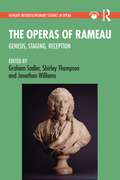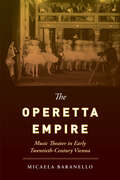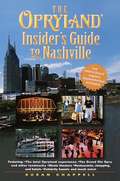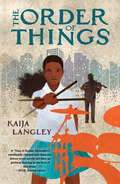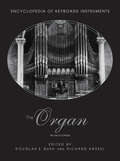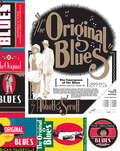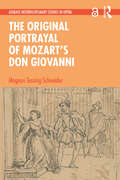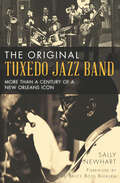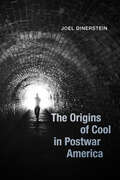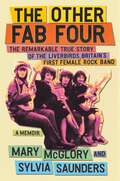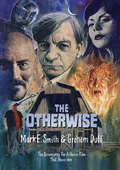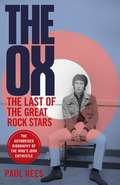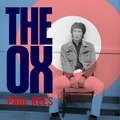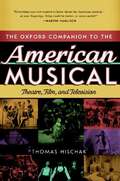- Table View
- List View
The Operas of Rameau: Genesis, Staging, Reception (Ashgate Interdisciplinary Studies in Opera)
by Jonathan Williams Graham Sadler Shirley ThompsonIn recent years, interest in Rameau’s operas has grown enormously. These works are no longer regarded as peripheral by performers and audiences but are increasingly staged in the world’s major opera houses and festivals, while the production of first-rate recordings on CD and DVD continues to flourish. Such welcome developments have gone hand in hand with an upsurge in research on Rameau and his period. The present volume, devoted solely to the composer’s operas, reflects this scholarly activity. It brings together a substantial group of essays by an international team of scholars on a wide range of aspects of Rameau’s operas. The individual essays are informed by a variety of disciplines or sub-disciplines including literature, archival studies, musical analysis, gender studies, ballet and choreography, dramaturgy and staging. The contents are addressed to a wide readership, including not only scholars but also practical musicians, stage directors, dancers and choreographers.
The Operatic Archive: American Opera as History (Ashgate Interdisciplinary Studies in Opera)
by Colleen RenihanThe Operatic Archive: American Opera as History extends the growing interdisciplinary conversation in opera studies by drawing on new research in performance studies and the philosophy of history. Moving beyond traditional aesthetic conceptions of opera, this book argues for opera’s powerful potential for historical impact and engagement in late twentieth- and twenty-first-century works by American composers. Considering opera’s ability to serve as a vehicle for memory, historical experience, affect, presence, and the historical sublime, this volume demonstrates how opera’s ability to represent and evoke historical events and historical experience differs fundamentally from the representations and recreations of other modes (specifically, literary and dramatic representations). Building on the work of performance scholars such as Joseph Roach, Rebecca Schneider, and Diana Taylor, and in consultation with recent debates in the philosophy of history, the book will be of interest to a wide range of scholars and researchers, particularly those working in the areas of opera studies and performance studies.
The Operetta Empire: Music Theater in Early Twentieth-Century Vienna
by Micaela Baranello"When the world comes to an end," Viennese writer Karl Kraus lamented in 1908, "all the big city orchestras will still be playing The Merry Widow." Viennese operettas like Franz Lehár's The Merry Widow were preeminent cultural texts during the Austro-Hungarian Empire's final years. Alternately hopeful and nihilistic, operetta staged contemporary debates about gender, nationality, and labor. The Operetta Empire delves into this vibrant theatrical culture, whose creators simultaneously sought the respectability of high art and the popularity of low entertainment. Case studies examine works by Lehár, Emmerich Kálmán, Oscar Straus, and Leo Fall in light of current musicological conversations about hybridity and middlebrow culture. Demonstrating a thorough mastery of the complex early twentieth-century Viennese cultural scene, and a sympathetic and redemptive critique of a neglected popular genre, Micaela Baranello establishes operetta as an important element of Viennese cultural life—one whose transgressions helped define the musical hierarchies of its day.
The Opryland Insider's Guide to Nashville
by Susan ChappellNashville is an attraction of the tourists. Susan Chappell, a top Nashville writer has information about this place- the best hotels, the music venues, theaters, a schedule of annual events, historic day trips, river cruises, and specialty shops.
The Orchestra of the Cappella Reale, Naples, 1750–1800 (Elements in Music and Musicians 1750-1850)
by Anthony R. DelDonnaThe most prestigious musical ensemble of early-modern Naples remained the Royal Chapel or Cappella Reale di Palazzo. Conceived to serve directly the ruling authority of the capital city – whether the viceroy (Spanish or Austrian) or monarchs (Carlo di Borbone then Ferdinando) – membership in this elite organization offered prestige, financial security, and access to the broader networks of music culture in Naples, attracting the best musicians within and beyond the physical confines of the capital. This Element introduces readers to the largely unknown history of the Neapolitan Cappella Reale in the second half of the eighteenth century. It is based on primary sources, reconstructing the entire personnel of the ensemble (1750–99), recovering previously unstudied contractual agreements, offering details about the musicians while also examining the original music of the principal musicians of the orchestra.
The Orchestral Music of Michael Tippett
by Thomas SchuttenhelmWith extracts from the composer's letters, writings, interviews and broadcasts, and supported by evidence from his sketchbooks and manuscripts, The Orchestral Music of Michael Tippett explores Tippett's intentions and argues that the experiences that triggered his creative impulses are integral to understanding his music. In his discussion of Tippett's creative process, Thomas Schuttenhelm attempts to recapture the circumstances under which Tippett's orchestral works were created, to document how his visionary aspirations were developed and sustained throughout the creative cycle, and to chart how conception was transmuted from idea through to performance. Analysing Tippett's orchestral works throughout his long career, from the Symphonic Movement of 1931 to his final masterpiece The Rose Lake in 1991–3, Schuttenhelm explores each work in detail to provide a comprehensive commentary on one of the most influential British composers of the twentieth century.
The Orchestral Revolution
by Emily I. DolanThe Orchestral Revolution explores the changing listening culture of the eighteenth and early nineteenth centuries. Delving into Enlightenment philosophy, the nature of instruments, compositional practices and reception history, this book describes the birth of a new form of attention to sonority and uncovers the intimate relationship between the development of modern musical aesthetics and the emergence of orchestration. By focusing upon Joseph Haydn's innovative strategies of orchestration and tracing their reception and influence, Emily Dolan shows that the consolidation of the modern orchestra radically altered how people listened to and thought about the expressive capacity of instruments. The orchestra transformed from a mere gathering of instruments into an ideal community full of diverse, nuanced and expressive characters. In addressing this key moment in the history of music, Dolan demonstrates the importance of the materiality of sound in the formation of the modern musical artwork.
The Order of Things
by Kaija LangleyA heart-rending novel-in-verse about a girl beginning to learn it is possible to go on even after a great loss.Eleven-year-old April Jackson loves playing the drums, almost as much as she loves her best friend, Zee, a violin prodigy. They both dream of becoming professional musicians one day. When Zee starts attending a new school that will nurture his talent, April decides it&’s time for her to pursue her dreams, too, and finally take drum lessons. She knows she isn&’t very good to start, but with Zee&’s support, she also knows someday she can be just as good as her hero, Sheila E., and travel all around the world with a pair of drumsticks in her hand.When the unthinkable happens and Zee suddenly passes away, April is crushed by grief. Without Zee, nothing is the way it&’s supposed to be. Zee's Dad isn't delivering the mail for his postal route like he should. April's Mom is suddenly dating someone new who is occupying too much space in their lives. And every time April tries to play the drums, all she can think about is Zee.April isn't sure how to move on from the awful feeling of being without Zee. Desperate to help Papa Zee, she decides to secretly deliver the mail he&’s been neglecting. But when on her route she discovers a classmate in trouble, she doesn&’t second guess what she knows is the right thing to do.
The Organ in Manitoba: A History of the Instruments, the Builders, and the Players
by James B. HartmanPipe organs were once a central (and sometimes hotly debated) part of Manitoba's cultural life. The Organ in Manitoba portrays that history--the instruments, builders, players and critics--from the date of the earliest known installations to the 1990s, and includes information on musical organizations such as the Royal Canadian College of Organists. It documents over a century of evolution and changes, from concepts of tonal design to styles of musical commentary and tastes, and includes an inventory of installations and specifications for over 100 organs. Well-illustrated with photographs and excerpts from historical reviews and other documents, it will be of interest to musicians, teachers, and music, church, and cultural historians.
The Organ: An Encyclopedia
by Richard KasselThe Encyclopedia of Organ includes articles on the organ family of instruments, including famous players, composers, instrument builders, the construction of the instruments, and related terminology. It is the first complete A-Z reference on this important family of keyboard instruments. The contributors include major scholars of music and musical instrument history from around the world.
The Organs of J.S. Bach: A Handbook
by Christoph Wolff Lynn Edwards Butler Markus ZepfThe Organs of J. S. Bach is a comprehensive and fascinating guide to the organs encountered by Bach throughout Germany in his roles as organist, concert artist, examiner, teacher, and visitor. Newly revised and updated, the book's entries are listed alphabetically by geographical location, from Arnstadt to Zschortau, providing an easy-to-reference overview. Includes detailed organ-specific information: high-quality color photographs each instrument's history, its connection to Bach, and its disposition as Bach would have known it architectural histories of the churches housing the instruments identification of church organists Lynn Edwards Butler's graceful translation of Christoph Wolff and Markus Zepf's volume incorporates new research and many corrections and updates to the original German edition. Bibliographical references are updated to include English-language sources, and the translation includes an expanded essay by Christoph Wolff on Bach as organist, organ composer, and organ expert. The volume includes maps, a timeline of organ-related events, transcriptions of Bach's organ reports, a guide to examining organs attributed to Saxony's most famous organ builder Gottfried Silbermann, and biographical information on organ builders. Publication of this volume is supported by the American Bach Society.
The Origin of Musical Instruments: An Ethnological Introduction to the History of Instrumental Music (Classic European Studies in the Science of Music)
by André SchaeffnerThe work of French musicologist, ethnologist and critic Andre Schaeffner (1895– 1980) grew out of his first organological studies of the history of Western classical instruments in the late 1920s and encapsulated in his wide-ranging Origine des instruments de musique, which captures his studies in Paris between 1931 and 1936. Almost 80 years after its first publication, the scientific relevance and influence of Schaeffner’s primary hypothesis—that the origins of music can be traced to the human body through gesture, dance and the movements in the use of musical instruments and their ancestor tools—remains pertinent in fields which have returned to informed speculative and empirical research on the origins of music. This first English edition is accompanied by editorial footnotes and introductory texts, and the influence of Schaeffner’s thought on several generations of musicologists makes his work an essential piece of reading for ethnomusicologists, music psychologists, organologists and musicologists interested in the history of their field.
The Original Blues: The Emergence of the Blues in African American Vaudeville (American Made Music Series)
by Lynn Abbott Doug SeroffBlues Book of the Year —Living BluesAssociation of Recorded Sound Collections Awards for Excellence Best Historical Research in Recorded Blues, Gospel, Soul, or R&B–Certificate of Merit (2018)2023 Blues Hall of Fame Inductee - Classic of Blues Literature categoryWith this volume, Lynn Abbott and Doug Seroff complete their groundbreaking trilogy on the development of African American popular music. Fortified by decades of research, the authors bring to life the performers, entrepreneurs, critics, venues, and institutions that were most crucial to the emergence of the blues in black southern vaudeville theaters; the shadowy prehistory and early development of the blues is illuminated, detailed, and given substance.At the end of the nineteenth century, vaudeville began to replace minstrelsy as America’s favorite form of stage entertainment. Segregation necessitated the creation of discrete African American vaudeville theaters. When these venues first gained popularity, ragtime coon songs were the standard fare. Insular black southern theaters provided a safe haven, where coon songs underwent rehabilitation and blues songs suitable for the professional stage were formulated. The process was energized by dynamic interaction between the performers and their racially-exclusive audience.The first blues star of black vaudeville was Butler “String Beans” May, a blackface comedian from Montgomery, Alabama. Before his bizarre, senseless death in 1917, String Beans was recognized as the “blues master piano player of the world.” His musical legacy, elusive and previously unacknowledged, is preserved in the repertoire of country blues singer-guitarists and pianists of the race recording era.While male blues singers remained tethered to the role of blackface comedian, female “coon shouters” acquired a more dignified aura in the emergent persona of the “blues queen.” Ma Rainey, Bessie Smith, and most of their contemporaries came through this portal; while others, such as forgotten blues heroine Ora Criswell and her protégé Trixie Smith, ingeniously reconfigured the blackface mask for their own subversive purposes.In 1921 black vaudeville activity was effectively nationalized by the Theater Owners Booking Association (T.O.B.A.). In collaboration with the emergent race record industry, T.O.B.A. theaters featured touring companies headed by blues queens with records to sell. By this time the blues had moved beyond the confines of entertainment for an exclusively black audience. Small-time black vaudeville became something it had never been before—a gateway to big-time white vaudeville circuits, burlesque wheels, and fancy metropolitan cabarets. While the 1920s was the most glamorous and remunerative period of vaudeville blues, the prior decade was arguably even more creative, having witnessed the emergence, popularization, and early development of the original blues on the African American vaudeville stage.
The Original Portrayal of Mozart’s Don Giovanni (Ashgate Interdisciplinary Studies in Opera)
by Magnus Tessing SchneiderThe Original Portrayal of Mozart’s Don Giovanni offers an original reading of Mozart’s and Da Ponte’s opera Don Giovanni, using as a lens the portrayal of the title role by its creator, the baritone Luigi Bassi (1766–1825). Although Bassi was coached in the role by the composer himself, his portrayal has never been studied in depth before, and this book presents a large number of new sources (first- and second-hand accounts), which allows us to reconstruct his performance scene by scene. The book confronts Bassi’s portrayal with a study of the opera’s early German reception and performance history, demonstrating how Don Giovanni as we know it today was not only created by Mozart, Da Ponte and Luigi Bassi but also by the early German adapters, translators, critics and performers who turned the title character into the arrogant and violent villain we still encounter in most of today’s stage productions. Incorporating discussion of dramaturgical thinking of the late Enlightenment and the difficult moral problems that the opera raises, this is an important study for scholars and researchers from opera studies, theatre and performance studies, music history as well as conductors, directors and singers.
The Original Tuxedo Jazz Band: More Than a Century of a New Orleans Icon (Music Ser.)
by Sally NewhartA lively look at the long career of these legendary musicians, from a Storyville dance hall to the White House and beyond. In 1910, the Tuxedo Jazz Band played its first show at the Tuxedo Dance Hall in Storyville under Oscar Celestin. The popular ensemble would go on to play all over New Orleans, as well as across the South and the nation—and in 1953, it became the first jazz band to play the White House. The band has punctuated jazz history and produced some of the most memorable musicians of the past century: Bob French, Albert French, William Ridgley, Octave Crosby, Louis Armstrong, and more. Author Sally Newhart has written a definitive and captivating history of the band from inception to present, including oral histories, archival photos, a discography, and a previously unpublished complete list of members since 1910.
The Origins and Ascendancy of the Concert Mass
by Stephanie RockeThe mass is an extraordinary musical form. Whereas other Western art music genres from medieval times have fallen out of favour, the mass has not merely survived but flourished. A variety of historical forces within religious, secular, and musical arenas saw the mass expand well beyond its origins as a cycle of medieval chants, become concertised and ultimately bifurcate. Even as Western societies moved away from their Christian origins to become the religiously plural and politically secular societies of today, and the Church itself moved in favour of congregational singing, composers continued to compose masses. By the early twentieth century two forms of mass existed: the liturgical mass composed for church services, and the concert mass composed for secular venues. Spanning two millennia, The Origins and Ascendancy of the Concert Mass outlines the origins and meanings of the liturgical texts, defines the concert mass, explains how and why the split occurred, and provides examples that demonstrate composers’ gradual appropriation of the genre as a vehicle for personal expression on serious issues. By the end of the twentieth century the concert mass had become a repository for an eclectic range of theological and political ideas.
The Origins of Cool in Postwar America
by Joel DinersteinAn “entertaining” study of the enduring concept of coolness, and the mix of cultures and historical events that shaped it (The New York Times).Cool. It was a new word and a new way to be, and in a single generation, it became the supreme compliment of American culture. The Origins of Cool in Postwar America uncovers the hidden history of this concept and its new set of codes that came to define a global attitude and style. As Joel Dinerstein reveals, cool began as a stylish defiance of racism, a challenge to suppressed sexuality, a philosophy of individual rebellion, and a youthful search for social change.Through portraits of iconic figures, he illuminates the cultural connections and artistic innovations among Lester Young, Humphrey Bogart, Robert Mitchum, Billie Holiday, Frank Sinatra, Jack Kerouac, Albert Camus, Marlon Brando, James Dean, and others. We eavesdrop on conversations among Jean-Paul Sartre, Simone de Beauvoir, and Miles Davis, and on a forgotten debate between Lorraine Hansberry and Norman Mailer over the “white Negro” and black cool. We come to understand how the cool worlds of Beat writers and Method actors emerged from the intersections of film noir, jazz, and existentialism. Out of this mix, Dinerstein sketches nuanced definitions of cool that unite concepts from African-American and Euro-American culture: the stylish stoicism of the ethical rebel loner; the relaxed intensity of the improvising jazz musician; the effortless physical grace of the Method actor. To be cool is not to be hip and to be hot is definitely not to be cool.“Eminently readable. Much more than just a history of cool, this book is a studied examination of the very real, often problematic social issues that popular culture responds to.” —Publishers Weekly (starred review)“The kind of book that makes learning enjoyable.” —The Wall Street Journal“Superb.” —Times Higher Education
The Other Fab Four: The Remarkable True Story of the Liverbirds, Britain's First Female Rock Band
by Mary McGlory Sylvia SaundersFor readers of Sheila Weller&’s Girls Like Us comes a fiercely feminist, heartwarming story of friendship and music about The Liverbirds, Britain&’s first all-female rock group. The idea for Britain&’s first female rock band, The Liverbirds, started one evening in 1962, when Mary McGlory, then age 16, saw The Beatles play live at The Cavern Club in Liverpool, the nightclub famously known as the &“cradle of British pop music.&” Then and there, she decided she was going to be just like them—and be the first girl to do it. Joining ranks in 1963 with three other working-class girls from Liverpool—drummer Sylvia Saunders and guitarists Valerie Gell and Pamela Birch, also self-taught musicians determined to &“break the male monopoly of the beat world&”—The Liverbirds went on to tour alongside the Rolling Stones, the Kinks, and Chuck Berry, and were on track to hit international stardom—until life intervened, and the group was forced to disband just five years after forming in 1968. Now, Mary and Sylvia, the band&’s two surviving members, are ready to tell their stories. From that fateful night in 1962, when Mary, who once aspired to become a nun, decided to provide for her family by becoming a rich-and-famous rocker, to the circumstances that led to the band splitting up—Sylvia&’s dangerously complicated pregnancy, and the tragic accident that paralyzed Valerie&’s beau—The Liverbirds tackles family, friendship, addiction, aging, and the forces—even destiny—that initially brought the four women together.
The Other Worlds of Hector Berlioz
by Inge Van RijBerlioz frequently explored other worlds in his writings, from the imagined exotic enchantments of New Zealand to the rings of Saturn where Beethoven's spirit was said to reside. The settings for his musical works are more conservative, and his adventurousness has instead been located in his mastery of the orchestra, as both orchestrator and conductor. Inge van Rij's book takes a new approach to Berlioz's treatment of the orchestra by exploring the relationship between these two forms of control - the orchestra as abstract sound, and the orchestra as collective labour and instrumental technology. Van Rij reveals that the negotiation between worlds characteristic of Berlioz's writings also plays out in his music: orchestral technology may be concealed or ostentatiously displayed; musical instruments might be industrialised or exoticised; and the orchestral musicians themselves move between being a society of distinctive individuals and being a machine played by Berlioz himself.
The Otherwise: The Screenplay for a Horror Film That Never Was
by Graham Duff Mark E SmithThe first ever publication of Mark E. Smith's supernatural film treatment, co-authored with Graham Duff.In 2015 Mark E. Smith of The Fall and screenwriter Graham Duff co-wrote the script for a horror feature film called The Otherwise. The story involved The Fall recording an EP in an isolated recording studio on Pendle Hill. The Lancashire landscape is not only at the mercy of a satanic biker gang, it's also haunted by a gaggle of soldiers who have slipped through time from the Jacobite Rebellion.However, every film production company who saw the script said it was 'too weird' to ever be made. The Otherwise is weird. Yet it's also witty, shocking and genuinely scary. Now the screenplay is published for the first time, alongside photographs, drawings and handwritten notes. The volume also contains previously unpublished transcripts of conversations between Smith and Duff, where they discuss creativity, dreams, musical loves (from Can to acid house) and favourite films (from Britannia Hospital to White Heat). Smith also talks candidly about his youth and mortality, in exchanges that are both touching and extremely funny.
The Ox: The Authorized Biography of The Who's John Entwistle
by Paul ReesThe definitive, no-holds-barred biography of John Entwistle, The Who's legendary bass guitaristIt is an unequivocal fact that in terms of rock bands, the Beatles, the Rolling Stones and the Who represent Year Zero; the beginning of all things, ground-breakers all. To that incontrovertible end, John Entwistle-the Who's beloved bassist-remains an enigmatic yet undeniably influential figure, renowned as much for his immense talent as for his gloriously oversized-seeming character. However, unlike his fellow musicians, Entwistle has yet to be the subject of a major biography. In the years since his death, his enduring legacy has been carefully guarded by his loved ones, preventing potential biographers from gaining close enough access to write a definitive account of his extraordinary life-until now. For the first time, and with the full co-operation of the Entwistle family, The Ox shines a long overdue light on one of the most important figures in rock history. Drawing on his own notes for an unfinished autobiography that he started before his death in 2002, as well as his personal archives and interviews with his family and friends, The Ox gives readers a never-before-seen glimpse into the two very distinct poles of John Entwistle. On the one hand, he was the rock star incarnate-larger than life, self-obsessed to a fault, and proudly and almost defiantly so. Extravagant with money, he famously shipped vintage American cars across the Atlantic without having so much as a driver's license, built exponentially bigger and grandiose bars into every home he owned, and amassed an extraordinary collection of possessions, from armor and weaponry to his patented Cuban-heel boots. But beneath this fame and flutter, he was also a man of simple tastes and traditional opinions. He was a devoted father and family man who loved nothing more than to wake up to a full English breakfast, or to have a supper of fish, chips, and a pint at his local pub. After his untimely death, many of these stories were shuttered away into the memories of his family and friends. At long last, The Ox introduces us to the man behind the myth-the iconic and inimitable John Entwistle.
The Ox: The Last of the Great Rock Stars: The Authorised Biography of The Who's John Entwistle
by Paul ReesThe definitive no-holds-barred biography of John Entwistle, The Who's legendary bass guitaristIt is an unequivocal fact that in terms of rock bands, the Beatles, the Rolling Stones and the Who represent Year Zero; the beginning of all things, ground-breakers all. To that end, John Entwistle - the Who's beloved bassist - is also without question one of the most important and influential figures in the annals of rock. He is also among an even more rarefied few by virtue of his being such a fascinating, transfixing and gloriously oversized character. However, Entwistle has not been the subject of a major biography. Likely, this was due to no-one being able to gain close access to the subject himself: the still in many other respects enigmatic Entwistle's enduring legacy has been carefully guarded by his surviving family. With the full co-operation of the Entwistle family, The Ox will correct this oversight and in doing so, shine a long overdue light on one of the single greatest, and most impactful figures in rock history.Drawing on his own notes for an unfinished autobiography that he started before his death in 2002 (and which will be quoted from extensively), as well as his personal archives and interviews with his family and friends, The Ox will give readers a never-before-seen glimpse into the two very distinct poles of John Entwistle. On the one hand, he was the rock star incarnate, being larger than life, self-obsessed to a fault, and proudly and almost defiantly so. Extravagant with money, he famously shipped two vintage American cars across the Atlantic without having so much as a driver's license, built exponentially bigger and grandiose bars into every home he owned, and amassed an extraordinary collection of possessions, from arachnids, armor, and weaponry, to his patented Cuban-heeled boots. But beneath this fame and flutter, he was also a man of simple tastes and traditional opinions. He was a devoted father and family man who loved nothing more than to wake up to a full English breakfast, or to have a supper of fish, chips, and a pint at his local pub.After his untimely death, many of these stories were shuttered away into the memories of his family, friends, and loved ones, but now, for the first time, The Ox will introduce us to the man behind the myth-the iconic and inimitable John Entwistle.
The Ox: The Last of the Great Rock Stars: The Authorised Biography of The Who's John Entwistle
by Paul Rees'A highly entertaining read' The Times Music Books of the Year'Eye-popping' The Times best summer booksThe definitive no-holds-barred biography of John Entwistle, The Who's legendary bass guitaristIt is an unequivocal fact that in terms of rock bands, the Beatles, the Rolling Stones and the Who represent Year Zero; the beginning of all things, ground-breakers all. To that end, John Entwistle - the Who's beloved bassist - is also without question one of the most important and influential figures in the annals of rock. He is also among an even more rarefied few by virtue of his being such a fascinating, transfixing and gloriously oversized character. However, Entwistle has not been the subject of a major biography. Likely, this was due to no-one being able to gain close access to the subject himself: the still in many other respects enigmatic Entwistle's enduring legacy has been carefully guarded by his surviving family. With the full co-operation of the Entwistle family, The Ox will correct this oversight and in doing so, shine a long overdue light on one of the single greatest, and most impactful figures in rock history.Drawing on his own notes for an unfinished autobiography that he started before his death in 2002 (and which will be quoted from extensively), as well as his personal archives and interviews with his family and friends, The Ox will give readers a never-before-seen glimpse into the two very distinct poles of John Entwistle. On the one hand, he was the rock star incarnate, being larger than life, self-obsessed to a fault, and proudly and almost defiantly so. Extravagant with money, he famously shipped two vintage American cars across the Atlantic without having so much as a driver's license, built exponentially bigger and grandiose bars into every home he owned, and amassed an extraordinary collection of possessions, from arachnids, armor, and weaponry, to his Cuban-heeled boots. But beneath this fame and flutter, he was also a man of simple tastes and traditional opinions. He was a devoted father and family man who loved nothing more than to wake up to a full English breakfast, or to have a supper of fish, chips, and a pint at his local pub.After his untimely death, many of these stories were shuttered away into the memories of his family, friends, and loved ones, but now, for the first time, The Ox will introduce us to the man behind the myth-the iconic and inimitable John Entwistle.
The Oxford Companion to the American Musical: Theatre, Film, and Television
by Thomas S. HischakFrom the silver screen to the Great White Way, small community theatres to television sets, the musical has long held a special place in America's heart and history. Now, in The Oxford Companion to the American Musical, readers who flocked to the movies to see An American in Paris or Chicago, lined up for tickets to West Side Story or Rent, or crowded around their TVs to watch Cinderella or High School Musical can finally turn to a single book for details about them all. For The first time, this popular subject has an engaging and authoritative book as thrilling as the performances themselves. With more than two thousand entries, this illustrated guide offers a wealth of information on musicals, performers, composers, lyricists, producers, choreographers, and much more. Biographical entries range from early stars Fred Astaire, Bing Crosby, Mary Martin, and Mae West to contemporary show-stoppers Nathan Lane, Savion Glover, and Kristin Chenoweth, while composers Irving Berlin, George Gershwin, Richard Rodgers, and Andrew Lloyd Webber all have articles, and the choreography of Bob Fosse, Tommy Tune, and Debbie Allen receives due examination. The plays and films covered range from modern hits like Mamma Mia! and Moulin Rouge! to timeless classics such as Yankee Doodle Dandy and Show Boat. Also, numerous musicals written specifically for television appear throughout, and many entries follow a work--Babes in Toyland for example--as it moves across genres, from stage, to film, to television. The Companion also includes cross references, a comprehensive listing of recommended recordings and further reading, a useful chronology of all the musicals described in the book, plus a complete index of Tony Award and Academy Award winners. Whether you are curious about Singin' in the Rain or Spamalot, or simply adore The Wizard of Oz or Grease, this well-researched and entertaining resource is the first place to turn for reliable information on virtually every aspect of the American musical. THOMAS HISCHAK is Professor of Theatre at the State University of New York College at Cortland. He is the author of sixteen books on theatre, film, and popular music, including The Oxford Companion to American Theatre; the textbook Theatre as Human Action; and the award-winning American Musical Theatre Song Encyclopedia. He is also the author of twenty published plays.
The Oxford Dictionary of Musical Terms
by Alison LathamPrinted music and writing about music involve the use of complex systems of notation and a wealth of technical terms in several languages. The Concise Oxford Dictionary of Musical Terms provides clear, succinct, definitions of a comprehensive range of the musical terms, in English and other European languages, that are likely to be encountered in Western music, including in jazz and popular musical genres. Over 2,500 A-Z entries range across a spectrum of subjects, among them: rhythm, metre, forms, genres, pitch, scales, chords, harmony and counterpoint, notational systems, composition and analysis, performance practice, tempo, expression, musical periods, artistic movements, computer applications, acoustics, and many more. Entries provide etymologies, and are fully cross-referenced. Some are illustrated with music examples and tables. An appendix lists all composers mentioned in the Dictionary, with their dates. It is an ideal book for students and teachers of music - it covers all the terms required in the SMAB musical theory exams - as well as for professional musicians, those learning to play musical instruments, and members of choirs, and musical groups. It will also be a useful quick reference book for concert-goers, CD-collectors, and radio listeners.
